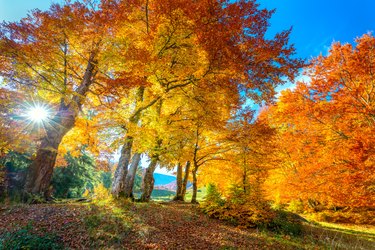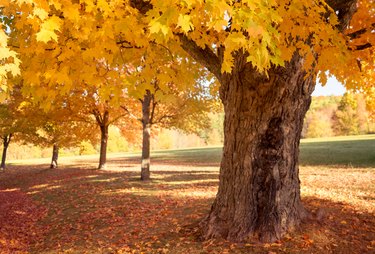
With over 130 varieties of maple trees (Acer) dotting landscapes across the Northern Hemisphere, charting a maple tree's lifespan may take several human generations. Noted for their long-life expectancy, maples are firmly rooted in the earth, and there's a variety to fit every landscaping need. The most popular are the Japanese maple (Acer palmatum) that can fit into tight spaces and are even used as bonsai, the Sugar Maple (Acer saccharum) that provides syrup for pancakes and baked goods, and the Red Maple (Acer rubrum), the American native sporting a fall display of bright red leaves.
Estimating a Maple Tree Lifespan
Video of the Day
Several environmental factors contribute to the lifespan of maple tree in general, and then there are the specifics of a particular variety of maple. Most maples thrive in U.S. Department of Agriculture hardiness zones 3 to 8. Human destruction or mistreatment of these noble trees also affect their life expectancy, as well as disease, draught and pests in forests that are not well-monitored. Urban settings also shorten the lifespan of a maple, as air quality and limb damage threaten the life of the tree. Root disease and fungus can also contribute to a shortened lifespan of a maple tree.
Video of the Day
The Japanese maple with its distinctive purple-red leaves can be expected to reach over 100 years of life. This tree is slow-growing, with only 1 to 2 feet of growth per year. The Sugar Maple is the old man of the woods, with a life expectancy of 200 to 300 years; this tree will display its glorious foliage for 80 to 100 years.
The Japanese Maple
A native of Japan with documentation reaching back to the 1700s, this variety was imported to England in the early 1820s. The tree can be hand-tended to grow in a container in both warmer and colder zones outside the USDA 5 to 8 recommended zones. In Japan, they are planted in western-facing gardens where the fall hits first, hence the tree's nickname "the autumn welcoming tree."
As they are low-growing trees, the Japanese maple reaches only about up 25 feet, with a spread of 10 to 20 feet. Its shallow root systems are imperiled by commercial landscaping machinery and standing water, contributing to a shorter life span. If treated right, the Japanese maple lives to greet a new century. In Japan, a delicacy is to store the leaves in salt for one year and then dip them in tempura batter and fry. This is a very popular snack in Osaka.
The Sugar Maple

One of the most important maples in the northeastern United States as well as the symbol on the Canadian flag, the Sugar Maple dominates the hardwood forest. It grows to a height of 50 to 70 feet with a majestically straight trunk. Its sap has been used for centuries to provide sweeteners to Native American and early European settlers. And today, maple syrup production is cherished, as the sap has twice the sugar content of other maples. Furniture, flooring and even bowling pins are made from Sugar Maple tree wood, and its grain is prized for cabinet making.
The extensive lifespan of a sugar maple depends, however, on maintaining a disease-free environment; with proper woodland treatment a Sugar Maple can live up to 400 years. However, a tapering off of the variety's growth has occurred over the last several years, with a higher-than-normal level of mortality. Research has shown that an aggregation of factors, including insect penetration, climate change and acid rain are all contributing to the shortened lifespan of the Sugar Maple.
The Red Maple

One of the few maples to penetrate the geography of the South, the Red Maple's versatility in accommodating different climate, soil and elevations contributes to its long life. Famous for its deep red and orange fall leaves, the Red Maple is a favorite of designers, artists and children who treasure the leaves and dive into fallen leaf piles.
The shortest life span of the variety, Red Maples are expected to live for about 80-100 years, given prime growing conditions. However, they start producing seeds at around 4 years old; those seeds can lay dormant on the floor of the woods for many years, or until an opening in the dense canopy above gives them the sun's energy for growth. They are highly susceptible to diseases and pests and fall easily in hurricanes and forest fires.